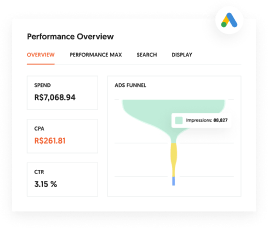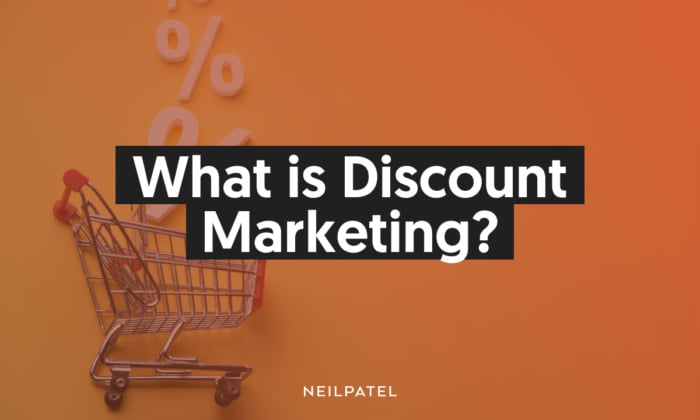
Consumers love to save money, of course. With that said, did you know that businesses can also benefit from discounts they offer to their customers?
From increasing revenue to driving conversions to getting more email newsletter sign-ups, discount marketing can be a powerful tool in your overall marketing strategy.
In this post, we’ll explore the psychology of discounts. We’ll then dig into our survey results regarding discounts which provide us with some valuable insights to consider. Finally, we’ll share how to optimize your discount marketing strategy using the psychology and these insights.
So if you’ve ever wondered how discount marketing might benefit your business, read on.
The Psychology Behind Discounts
It’s true that the vast majority of consumers would love to save some money. That’s not up for debate.
As with many things marketing, though, there are a lot of psychological factors that come into play when it comes to discounts.
What do I mean?
Take FoMO, or Fear of Missing Out, as an example.
FoMO is a relatively new psychological phenomenon. The term was coined in 2004, and it has seen widespread use since 2010. While the term is pretty self-explanatory, British psychologists defined it as “pervasive apprehension that others might be having rewarding experiences from which one is absent.”
Fear of missing out on a great deal isn’t the only reason discounts are so compelling, though.
Discounts can also make consumers happier, even if only for long enough to place an order.
One study found that a $10 voucher while online grocery shopping was enough to increase oxytocin (the happy hormone) levels by 14%!
Further, participants in the study who received a coupon reported that they were 49% happier after the study than before. This is in comparison to the group who did not receive a coupon, as they reported they were only 31% happier following the study.
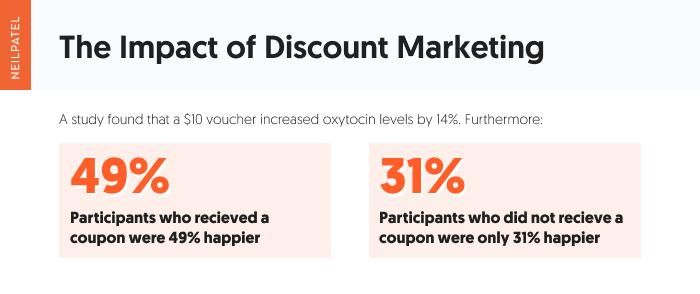
Now let’s consider the marketing side of discounts. They can be an incredibly powerful tool for your brand to use. Here’s why.
- Discounts contribute to a scarcity mindset. This activates the Fear of Missing Out, but it also triggers an underlying “need” to make a purchase they might not otherwise.
- Discounts create a sense of urgency. Consumers are likely to make a purchase, even one they have been pondering for months, if a discount is offered.
- Discounts discourage consumers from comparison shopping. When a discount is offered, the consumer may assume (rightly or wrongly) that your price is the best. This means they are less likely to check out your competition.
- Discounts impact perceived value. Depending on your brand, discounts may cause consumers to perceive the value of your product more highly. However, it can also have the opposite effect. So, consider all possibilities when discounting your items.
As mentioned in the last point, discounts do have some cons.
If you’re a luxury brand, for example, then discounting a high-end product after just three months on the market probably won’t bode well for its perceived value. In fact, a discount, in that case, may inadvertently dissuade your customers from purchasing.
If your customer base is one who values a good deal, though, then discounts are unlikely to change their perception of your brand’s value.
Also, consider how often you offer discounts. Discounts certainly have their time and place in a marketing strategy, but use them too often (whatever that means for your customer base), and you create an expectation with your customers that you may not be able to live up to over time.
Discount Types
We mentioned the various psychological impacts that a discount can have on a consumer, such as creating a sense of urgency or contributing to a scarcity mindset.
Those impacts are largely driven by the type of discount that is offered.
There are many discount types available, but the most common ones include:
- Buy one, get one free
- Percentage discount (e.g., 20% off)
- Dollar discount (e.g., $5 off)
- Tiered discount (e.g., $5 off $50, $15 off $100, etc.)
- Bulk discount (e.g., save 10% when you buy 5)
- Free shipping
- Rebates
When deciding which discount type will be most effective, remember The Rule of 100. This rule was developed – and tested – by marketing professor Jonah Berger, Ph.D.
Here is a summary of The Rule of 100:
- A percentage discount is more appealing to customers if the item is under $100.
- A dollar discount is more appealing to customers if the item is over $100.
If you put on your “consumer hat,” it makes sense! A $5 discount on a $50 pair of sunglasses doesn’t sound as impressive as a 10% off discount on that same item. Similarly, 20% off of a $1,000 laptop doesn’t sound as good of a deal as $200 off.
Or, you could be ahead of the game like Dell and include both dollar amount and percentage saved:

As a marketer or business owner, it’s important to test out the different discount types with your particular audience. You may be surprised at which discounts your customers respond to most positively.
What Our Data Shows Us About Discount Marketing
Psychology and marketing are intrinsically linked. In fact, marketing psychology is an area of study within the larger field of psychology. It’s no surprise, then, that our data backs up a lot of the points in the previous section.
For this survey, we asked 1000 people in the United States to answer questions about discount marketing. This is what we found.
Consumers Who Don’t Typically Purchase on the First Visit Would Do So for a Discount
We asked: If you generally don’t make a purchase the first time you visit a site, what would change your mind?
54.97% of the respondents said they would make a purchase for a discount.
Of the aforementioned 54.97%:
- 61.91% of them would return to an abandoned cart if they got an email with a discount.
- 82.77% of them would add additional items to their purchase to meet the threshold for free shipping.
- 91.49% of them are likely to sign up or add their email address to an email list when shopping to get discounts.
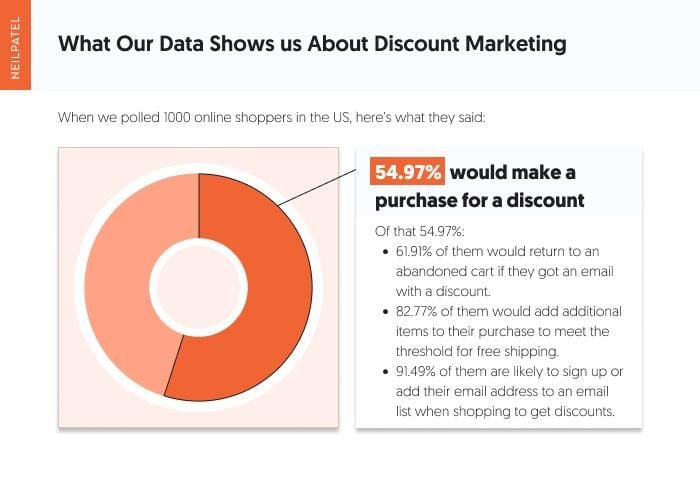
Consumers Who Abandoned Their Cart Would Convert if Offered a Discount
For the next part of the survey, we asked customers what would make them come back to an abandoned cart.
Almost half (49.6%) of respondents said that if they received an email with a discount, they would come back and purchase. 15.5% of respondents said an email promising a free item would entice them to convert.
So, an email like this from Soma has a solid chance of converting a previously non-converting customer:
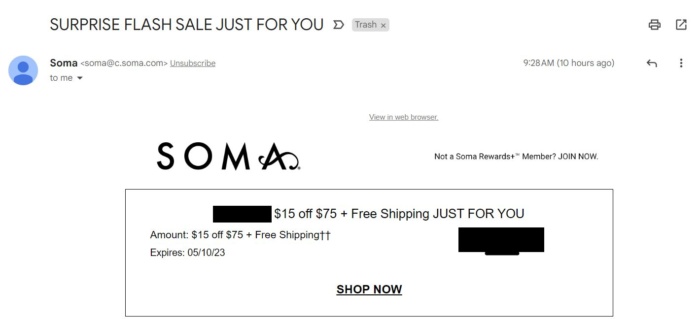
Of the remaining respondents, 16.8% said that an email reminding them of the specific items in their cart would likely get them to return. 15% said a generic email reminder was enough. The remaining 3.1% did not have strong opinions on the matter, so stated “other.”
Consumers Will Take Additional Steps to Receive a Discount
For the final portion of the survey, we asked respondents which additional steps they would be willing to take to receive a discount.
In particular, we included adding their email address to a newsletter form, adding additional items to their cart to meet the threshold for free shipping, and leaving a review for a promised future discount.
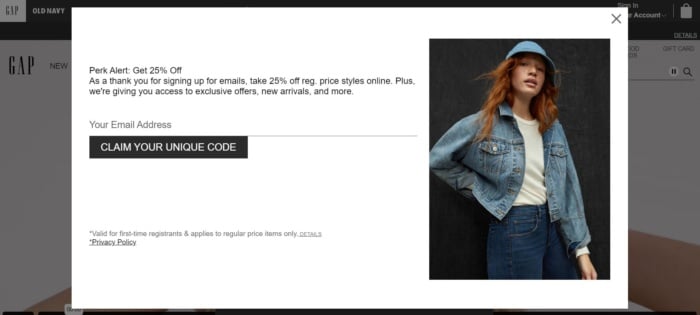
86% of the respondents said they were likely to sign up or add their email address when shopping to receive discounts.
78.1% of the respondents said they would add additional items to their cart to meet the threshold for free shipping.
For the last one, leaving a review in exchange for a discount, only 471 out of 1,000 respondents answered. Of those 471 respondents, 45.22% said they would fill out a review because a future discount was promised to them for doing so.
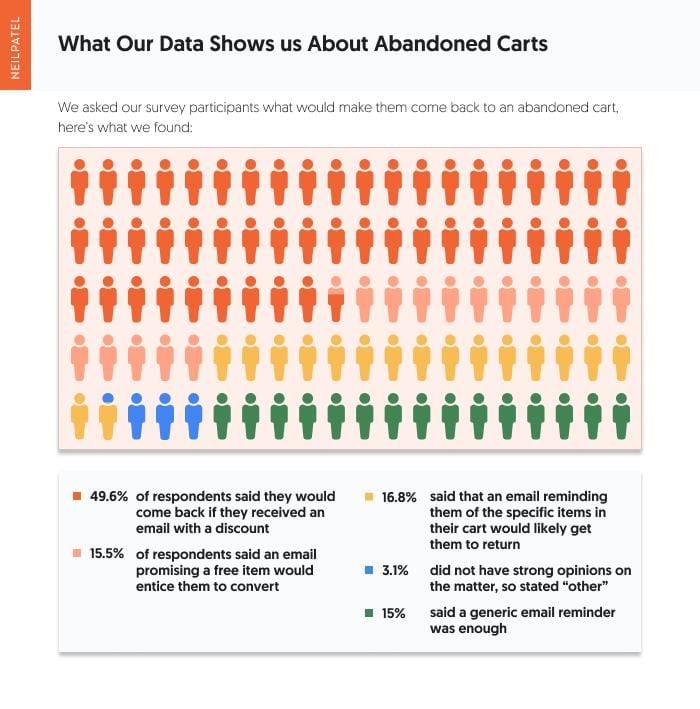
What We Learned from Our Data About Discount Marketing
There are three main things we learned from our survey data:
- Consumers who don’t typically purchase on the first visit would do so for a discount.
- Consumers who abandoned their cart would convert if offered a discount.
- Consumers will take additional steps to receive a discount.
Let’s dig a bit deeper into those learnings.
There are a lot of things that motivate consumers to make a purchase with your brand. From product availability to price to company values, consumers will often use multiple data points to make a decision. This is known as consumer shopping behavior.
In many cases, a discount can be the deciding factor for the consumer.
So, whether they’ve only browsed on your site just to leave and look elsewhere, or they’ve abandoned their cart entirely, a discount can be a strong motivation to return and convert.
Why?
Users want to feel like they are saving money. It may help them to justify the purchase in their mind if they perceive the savings to be too good of a deal to pass up.
So how can companies benefit from these learnings?
Companies should analyze how they can incorporate discounts into their marketing plans to help encourage more conversions. The end goal may not even be sales, but instead more email newsletter sign-ups or more reviews.
At the end of the day, companies would be remiss not to strategically include discounts in their marketing efforts.
How Can You Improve Your Discount Marketing Strategy?
So now that we’ve analyzed the data, it’s time to ask how you can use that information to improve your own discount marketing strategy.
The first step is to know the why behind offering discounts.
Let’s face it: as marketers, our main goal is not to save our customers money. However, we may recognize the benefits of offering discounts to our customers. So, we need to understand the underlying why from a business perspective so we can come up with a plan.
For example, if you want to increase Average Order Value (AOV), you may want to introduce a free shipping threshold on your website. That means that customers would have to spend $75 (or whatever amount you determine) to receive free economy shipping.
Or perhaps your goal is to improve your conversion rate. A great place to start is with abandoned carts. A 10% discount may be all that your customer base needs to drive conversion.
Once you know the why, it’s time to work out the how.
Let’s say that discounts will be a regular part of your marketing strategy, particularly when it comes to abandoned carts or getting more email signups. If that’s the case, you may need to tweak your pricing to accommodate. After all, you don’t want to regularly go into the red.
You will also need to spend time testing out various discount types and their impact on your conversion rate. The percentage or dollar amount off that your customer base responds to will differ widely from other brands. So, while checking out what other brands in your space are doing can be helpful to start, just know you may have to tweak for the best results.
FAQs
Do you have more questions about discount marketing? We have the answers to the most commonly asked questions on the topic.
Discount marketing is a common marketing strategy that utilizes promotions and discounts to entice customers to buy your products or services. The strategy may utilize short-term or long-term discount campaigns.
A discount pricing strategy is another term for discount marketing. It involves offering a product for a lower price than its market value to increase sales.
Before it or not, marketing psychology and, by extension, pricing psychology, are very real fields of study for marketers and psychologists. Discounts have been shown to increase scarcity, create a sense of urgency, and boost feelings of happiness. When used sparingly, discounts can also cause Fear of Missing Out, or FoMo, in consumers.
Conclusion
Discount marketing requires an understanding of your customer base and a willingness to experiment. It also requires you to consider many factors, such as what you’ll discount, how much, how long, and how often.
The good news is that, when implemented purposefully, discount marketing can be a boon to your business. Whether that’s through increased revenue, a higher AOV, or a higher conversation rate, discount marketing can give your business the extra boost it needs.
Best of all, you don’t need much to start. You can start small, testing out various types of discounts over a few months to see which ones your customers respond to most favorably. From there, you can begin to more strategically include discount marketing in your marketing toolbox.
Do you have plans to implement discount marketing for your business? Let us know in the comments below.

See How My Agency Can Drive More Traffic to Your Website
- SEO - unlock more SEO traffic. See real results.
- Content Marketing - our team creates epic content that will get shared, get links, and attract traffic.
- Paid Media - effective paid strategies with clear ROI.
Are You Using Google Ads? Try Our FREE Ads Grader!
Stop wasting money and unlock the hidden potential of your advertising.
- Discover the power of intentional advertising.
- Reach your ideal target audience.
- Maximize ad spend efficiency.

